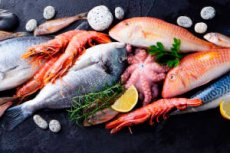High seafood consumption has been linked to exposure to "everlasting chemical compounds'"
Last reviewed: 07.06.2024

All iLive content is medically reviewed or fact checked to ensure as much factual accuracy as possible.
We have strict sourcing guidelines and only link to reputable media sites, academic research institutions and, whenever possible, medically peer reviewed studies. Note that the numbers in parentheses ([1], [2], etc.) are clickable links to these studies.
If you feel that any of our content is inaccurate, out-of-date, or otherwise questionable, please select it and press Ctrl + Enter.

Per- and polyfluoroalkyl substances, or PFASs, are a class of man-made chemicals that are considered "perpetual chemicals" because they remain in the environment for long periods of time.
Research on human exposure to PFAs is ongoing, as exposure to these chemicals has been linked to a number of serious diseases.
Some foods may contain chemicals, and depending on where you live, your drinking water may contain PFAs. Forever chemicals are also found in some types of food packaging.
Now research shows that the risk of PFAV exposure is even higher for people who eat a lot of seafood.
The study authors are not suggesting that people avoid fish consumption entirely, as seafood has many health benefits and PFABs are generally widespread in the environment.
Seafood consumption and exposure to PFAWs
Researchers examined dietary habits and PFAS exposure in people living in Portsmouth, New Hampshire, an area where seafood consumption is particularly popular. The study consisted of two parts.
Researchers surveyed 1,829 New Hampshire residents in June 2021 to find out what seafood they consume and in what quantities. The study included seafood consumption data for adults and children ages 2 to 11.
Among adults, 95% reported eating seafood in the past year, most often:
- Shrimp;
- Haddock;
- Salmon;
- Canned tuna.
The researchers also purchased and analyzed a "seafood basket" of the most commonly consumed types of seafood at the Portsmouth Market for analysis and found 26 types of PFAV compounds in the purchased products.
For shrimp and lobster, PFAV concentrations ranged from below detection limit to 1.74 and 3.30 ng/g, respectively.
These results suggest that people who eat a lot of seafood may consume additional concentrations of PFAVs.
What are the hazards associated with PFAW?
In addition to their toxicity, much remains currently unknown about the effects of PFAVs.
However, the Environmental Protection Agency (EPA) recommends minimizing exposure to PFAVs as much as possible.
The study's senior investigator, Megan Romano, PhD, assistant professor of epidemiology at Dartmouth College's Geisel School of Medicine, explained that PFAVs are "a large family of highly persistent man-made chemicals that contain carbon-fluoride."
They originated nearly eight decades ago and are used in a variety of consumer products that are resistant to water, stains and grease.
"PFAs affect a wide range of biological systems in the body and have a wide range of adverse health effects," Romano said.
"Every day we learn more about the health effects of PFAVs, but studies have shown a link between PFAVs and higher cholesterol levels, small reductions in birth weight, pregnancy-induced hypertension, reduced antibody response to vaccines, and even kidney and testicular cancer."
- Megan Romano, Ph.D., senior researcher.
Where do PFAVs typically occur?
Registered dietitian Christine Kirkpatrick, a registered dietitian who was not involved in the study, explained how PFAVs get into the human body.
" PFAAs can also be found in cleaning solutions, non-stick cookware and even personal care items," Kirkpatrick said.
"However, the main route of exposure estimated is likely to be people who work in industries where there is greater access and they may have a higher level of exposure than the general population," she added.
"There were also more cases in communities where drinking water was contaminated with PFAVs, as well as food that is grown or lived in areas with higher levels of PFAVs," Kirkpatrick said.
Romano noted that people in the United States can be exposed to PFAVs through drinking water and their diet.
"Dietary sources of PFAs include seafood, but PFAs are also found in other foods such as meat and dairy products, and they can get into our food from certain types of food packaging such as pizza boxes and microwave popcorn bags," Romano said.
Therefore, preventing PFAs from entering the environment is critical because of their persistence there and in our bodies.
Romano suggested that the EPA's new PFAS recommendations for drinking water are likely to bring more attention to PFAS hazards than before.
Is it safe to eat seafood?
Romano emphasized that her study is not meant to discourage people from eating seafood.
The problem with PFAVs is more complex, especially when you consider the many other routes of entry into the human body.
"The scientific community is working hard to better understand the overall risk-benefit ratio of seafood consumption," Romano said.
"Part of the current challenge for consumers is that some of the traditionally safer seafood in terms of mercury may have higher concentrations of other contaminants such as PFAVs. This really emphasizes the importance of a balanced diet that includes a wide variety of healthy food choices," Romano explained.
Does seafood bring health benefits?
Kirkpatrick noted that fish is "one of the most nutritious foods on the planet" and serves as an excellent source of nutrients, including:
- Protein;
- Omega-3 fatty acids;
- B vitamins;
- Vitamin D;
- Other vitamins and minerals.
"Fish is often found in diets that have been extensively studied to have a positive effect on longevity, heart and brain health, and overall longevity," Kirkpatrick added.
For example, fish takes center stage in the Mediterranean and Scandinavian diets.
Current recommendations call for a minimum of 2 to 2.5 servings of seafood per week for children and adults, Kirkpatrick said.
People who are pregnant or breastfeeding should eat at least 3 servings per week.
The study was published in journal Exposure and Health.
